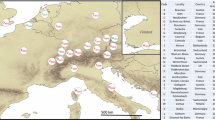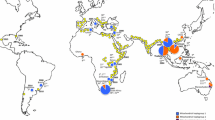Abstract
Native to China and the Korean Peninsula, the Asian longhorned beetle (ALB), Anoplophora glabripennis, has been introduced to North America and Europe. In both its native range and the territory it has invaded, ALB is responsible for the death or removal of millions of urban, roadside, and forest trees. Here, we present the population genetic structure of ALB in South Korea, using 801 bp of mitochondrial DNA and the most comprehensive sampling to date. ALB populations in South Korea are divided into three distinct geographical subgroups: the northeastern natural forest, and the western and southern urban areas. Historical records suggest that the forest-dwelling subgroup is native, as does the moderate genetic diversity of this population. Meanwhile, the fact that ALB was first observed in the western and southern areas only recently, the extreme genetic bottleneck status of these populations, their distribution in large port cities and adjacent areas, and the difference in observed host plants used by the forest subgroup and the urban subgroups suggest that the urban populations are non-native recent invaders. Approximate Bayesian computation suggests that the western and southern subgroups most likely originated from northeastern and northwestern China, respectively. Therefore, our study demonstrates that ALB invasion has occurred even within the species’ native territory. This finding alters our perception of biological invasion by providing a unique example of a species that has invaded its own native range.




Similar content being viewed by others
References
Beaumont MA, Zhang WY, Balding DJ (2002) Approximate Bayes-ian computation in population genetics. Genetics 162:2025–2035
Carter ME, Smith MT, Harrison RG (2009) Patterns of genetic variation among populations of the Asian longhorned beetle (Coleoptera: Cerambycidae) in China and Korea. Ann Entomol Soc Am 102(5):895–905
Carter ME, Smith MT, Harrison RG (2010) Genetic analyses of the Asian longhorned beetle (Coleoptera, Cerambycidae, Anoplophora glabripennis), in North America, Europe and Asia. Biol Invasions 12(5):1165–1182
Clement M, Posada D, Crandall KA (2000) TCS: a computer program to estimate gene genealogies. Mol Ecol 9:1657–1659
Cornuet JM, Pudlo P, Veyssier J, Dehne-Garcia A, Gautier M, Leblois R, Marin J-M, Estoup A (2014) DIYABC v2.0: a software to make approximate Bayesian computation inferences about population history using single nucleotide polymorphism, DNA sequence and microsatellite data. Bioinformatics 30:1187–1189
Dethier VG (1959) Food-plant distribution and density and larval dispersal as factors affecting insect populations. Can Entomol 91(9):581–596
Ellstrand NC, Schierenbeck KA (2000) Hybridization as a stimulus for the evolution of invasiveness in plants? Proc Natl Acad Sci USA 97(13):7043–7050
Essl F, Bacher S, Blackburn TM, Booy O, Brundu G, Brunel S et al (2015) Crossing frontiers in tackling pathways of biological invasions. Bioscience 65:769–782
Estoup A, Guillemaud T (2010) Reconstructing routes of invasion using genetic data: why, how and so what? Mol Ecol 19:4113–4130
European and Mediterranean Plant Protection Organization (EPPO) Global Database (2019) https://gd.eppo.int/taxon/AnOLGL/reporting
Excoffier L, Lischer HE (2010) Arlequin suite ver 3.5: a new series of programs to perform population genetics analyses under Linux and Windows. Mol Ecol Resour 10(3):564–567
Facon B, Jarne P, Pointier JP, David P (2005) Hybridization and invasiveness in the freshwater snail Melanoides tuberculata: hybrid vigour is more important than increase in genetic variance. J Evol Biol 18(3):524–535
Food and Agriculture Organization (2019) FAO glossary of phytosanitary terms. OEPP
Fraimout A, Debat V, Fellous S, Hufbauer RA, Foucaud J, Pudlo P, Estoup A (2017) Deciphering the routes of invasion of Drosophila suzukii by means of ABC random forest. Mol Biol Evol 34:980–996
Haack RA, Cavey JF, Hoebeke ER, Law K (1996) Anoplophora glabripennis: a new tree-infesting exotic cerambycid invades New York. Michigan Ent Soc Newsl 41(2–3):1–3
Haack RA, Hérard F, Sun J, Turgeon JJ (2010) Managing invasive populations of Asian longhorned beetle and citrus longhorned beetle: a worldwide perspective. Annu Rev Entomol 55:521–546
Harrison S (1994) Resources and dispersal as factors limiting a population of the tussock moth (Orgyia vetusta), a flightless defoliator. Oecologia 99:27–34
Hulme PE (2009) Trade, transport and trouble: managing invasive species pathways in an era of globalization. J Appl Entomol 46(1):10–18
Hurley BP, Garnas J, Wingfield MJ, Branco M, Richardson DM, Slippers B (2016) Increasing numbers and intercontinental spread of invasive insects on eucalypts. Biol Invasions 18(4):921–933
Hwang SH (2015) Long-horned beetles in Korea. In: Checklist of organisms in Korea, vol 14. Nature and Ecology, Seoul
Jang HK, Lee SH, Choi W (2015) Cerambycidae of Korea. Geobook, Seoul
Javal M, Roux G, Roques A, Sauvard D (2018) Asian Long-horned Beetle dispersal potential estimated in computer-linked flight mills. J Appl Entomol 142(1–2):282–286
Javal M, Lombaert E, Tsykun T, Courtin C, Kerdelhué C, Prospero S, Roques A, Roux G (2019a) Deciphering the worldwide invasion of the Asian long-horned beetle: a recurrent invasion process from the native area together with a bridgehead effect. Mol Ecol 28(5):951–967
Javal M, Roques A, Haran J, Hérard F, Keena M, Roux G (2019b) Complex invasion history of the Asian long-horned beetle: fifteen years after first detection in Europe. J Pest Sci 92(1):173–187
Kalyaanamoorthy S, Minh BQ, Wong TK, von Haeseler A, Jermiin LS (2017) ModelFinder: fast model selection for accurate phylogenetic estimates. Nat Methods 14(6):587
Katoh K, Rozewicki J, Yamada KD (2017) MAFFT online service: multiple sequence alignment, interactive sequence choice and visualization. Brief Bioinform 20:1160–1166
Kim MS, Kim KY, Lee W, Hong KJ (2019) Reporting the possibility of invasive populations of Anoplophora spp in Korea. J Asia Pac Biodivers 12(2):211–216
Kumar S, Stecher G, Tamura K (2016) MEGA7: molecular evolutionary genetics analysis version 7.0 for bigger datasets. Mol Biol Evol 33(7):1870–1874
Lee SM (1987) The longicorn beetles of Korean Peninsula. National Science Museum, Seoul
Lee HS, Wilson SW (2010) First report of the Nearctic flatid planthopper Metcalfa pruinosa (Say) in the Republic of Korea (Hemiptera: Fulgoroidea). Entomol News 121(5):506–513
Lim JL, Kim KG, Lim JO, Choi IJ, Park J, Park JK (2014) First record of Anoplophora freyi (Coleoptera: Cerambycidae: Lamiinae) in Korea. Entomol Res Bull 30(1):64–67
Lingafelter SW, Hoebeke ER (2002) Revision of the genus Anoplophora (Coleoptera: Cerambycidae) (No. 595.7648 L5). Entomological Society of Washington, Washington, DC
Linsley EG (1959) Ecology of cerambycidae. Annu Rev Entomol 4(1):99–138
Lombaert E, Guillemaud T, Cornuet JM, Malausa T, Facon B, Estoup A (2010) Bridgehead effect in the worldwide invasion of the biocontrol harlequin ladybird. PLoS ONE 5(3):e9743
Lombaert E, Ciosi M, Miller NJ, Sappington TW, Blin A, Guillemaud T (2018) Colonization history of the Western Corn Rootworm (Diabrotica virgifera virgifera) in North-America: insights from random forest ABC using microsatellite data. Biol Invasions 20:665–677
Lopez VM, Hoddle MS, Francese JA, Lance DR, Ray AM (2017) Assessing flight potential of the invasive Asian longhorned beetle (Coleoptera: Cerambycidae) with computerized flight mills. J Econ Entomol 110(3):1070–1077
Lowe S, Browne M, Boudjelas S, De Poorter M (2000) 100 of the world’s worst invasive alien species: a selection from the global invasive species database, vol 12. Invasive Species Specialist Group, Auckland
Lyu DP, Lee HS (2017) The red imported fire ant, Solenopsis invicta Buren (Hymenoptera: Formicidae: Myrmicinae) discovered in Busan sea port, Korea. Korean J Appl Entomol 56(4):437–438
Mankin RW, Smith MT, Tropp JM, Atkinson EB, Jong DY (2008) Detection of Anoplophora glabripennis (Coleoptera: Cerambycidae) larvae in different host trees and tissues by automated analyses of sound-impulse frequency and temporal patterns. J Econ Entomol 101(3):838–849
Meng PS, Hoover K, Keena MA (2015) Asian Longhorned Beetle (Coleoptera: Cerambycidae), an introduced pest of maple and other hardwood trees in North America and Europe. J Integr Pest Manag 6:4
Ministry of Oceans and Fisheries (MOF) (2018) Total volume of cargo handled by major ports. http://www.index.go.kr/potal/stts/idxMain/selectPoSttsIdxSearch.do?idx_cd=1265&stts_cd=126502&freq=Y
Múrias dos Santos A, Cabezas MP, Tavares AI, Xavier R, Branco M (2015) tcsBU: a tool to extend TCS network layout and visualization. Bioinformatics 32(4):627–628
Ohbayashi N, Ogawa J, Su ZH (2009) Phylogenetic analysis of the Lamiine genus Anoplophora and its relatives (Coleoptera, Cerambycidae) based on the mitochondrial COI gene. Special Bull Japanese Soc Coleopterol 7:309–324
Prospero S, Cleary M (2017) Effects of host variability on the spread of invasive forest diseases. Forests 8(3):80
Puillandre N, Dupas S, Dangles O, Zeddam JL et al (2008) Genetic bottleneck in invasive species: the potato tuber moth adds to the list. Biol Invasions 10(3):319–333
Roques A (2010) Alien forest insects in a warmer world and a globalised economy: impacts of changes in trade, tourism, and climate on forest biosecurity. New Zeal J For Sci 40:77–94
Schierenbeck KA, Ellstrand NC (2009) Hybridization and the evolution of invasiveness in plants and other organisms. Biol Invasions 11(5):1093–1105
Seebens H et al (2017) No saturation in the accumulation of alien species worldwide. Nat Commun 8:14435
Shi J, Macel M, Tielbörger K, Verhoeven KJ (2018) Effects of admixture in native and invasive populations of Lythrum salicaria. Biol Invasions 20(9):2381–2393
Sjöman H, Östberg J, Nilsson J (2014) Review of host trees for the wood-boring pests Anoplophora glabripennis and Anoplophora chinensis: an urban forest perspective. Arboric Urban For 40:143–164
Smith MT, Tobin PC, Bancroft J, Li G, Gao R (2004) Dispersal and spatiotemporal dynamics of Asian longhorned beetle (Coleoptera: Cerambycidae) in China. Environ Entomol 33(2):435–442
Stamatakis A (2014) RAxML version 8: a tool for phylogenetic analysis and post-analysis of large phylogenies. Bioinformatics 30(9):1312–1313
Trotter RT, Pepper E, Davis K, Vazquez R (2019) Anisotropic dispersal by the Asian longhorned beetle (Anoplophora glabripennis): quantifying spatial risk and eradication effort with limited biological data. Biol Invasions 21:1179–1195
Tsykun T, Javal M, Hölling D, Roux G, Prospero S (2019) Fine-scale invasion genetics of the quarantine pest, Anoplophora glabripennis, reconstructed in single outbreaks. Sci Rep 9(1):19436
van Kleunen M, Rockle M, Stift M (2015) Admixture between native and invasive populations may increase invasiveness of Mimulus guttatus. Proc R Soc B Biol Sci. 282:20151487
Wenhua L (2004) Degradation and restoration of forest ecosystems in China. For Ecol Manag 201(1):33–41
Williams DW, Lee HP, Kim IK (2004) Distribution and abundance of Anoplophora glabripennis (Coleoptera: Cerambycidae) in natural Acer stands in South Korea. Environ Entomol 33(3):540–545
Woo KS (1961) Studies on the Hyphantria cunea (Drury), a newly introduced insect pest. Seoul Natl Univ Bull Agric Biol 5:11–23
Yang XM, Sun JT, Xue XF, Li JB, Hong XY (2012) Invasion genetics of the western flower thrips in China: evidence for genetic bottleneck, hybridization and bridgehead effect. PLoS ONE 7(4):e34567
Acknowledgements
The first author would like to acknowledge Dr. Eric Lombaert for his invaluable cooperation for ABC analyses. The first author also thanks Hyunkyu Jang, Woong Choi, Jaedong Kim, and Seung-gu Son for their invaluable cooperation on ALB collection. Prof. Yeonjae Bae (KEIU) and Mr. Jaewon Ryu (EWUC) are acknowledged for allowing examination of the museum specimens. We also thank Prof. Yang-Seop Bae, Prof. Bong-Kyu Byun, Prof. Jong Kyun Park, Prof. Young-Seuk Park, and their laboratory members for their cooperation on the field survey in 2019. This research was supported by the R&D Program for Forest Science Technology (FTIS 2017042A00-1823-CA01) provided by Korea Forest Service (Korea Forestry Promotion Institute) and by Korea Environment Industry and Technology Institute (KEITI) through Exotic Invasive Species Management Program, funded by Korea Ministry of Environment (MOE) (2018002270005).
Author information
Authors and Affiliations
Corresponding author
Additional information
Communicated by C. Stauffer.
Publisher's Note
Springer Nature remains neutral with regard to jurisdictional claims in published maps and institutional affiliations.
Electronic supplementary material
Below is the link to the electronic supplementary material.
Rights and permissions
About this article
Cite this article
Lee, S., Lee, Y. & Lee, S. Population genetic structure of Anoplophora glabripennis in South Korea: Invasive populations in the native range?. J Pest Sci 93, 1181–1196 (2020). https://doi.org/10.1007/s10340-020-01245-3
Received:
Revised:
Accepted:
Published:
Issue Date:
DOI: https://doi.org/10.1007/s10340-020-01245-3




